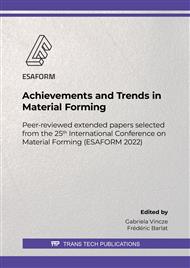p.1832
p.1842
p.1850
p.1864
p.1874
p.1882
p.1890
p.1900
p.1907
Role of Viscosity on Optimum Polymer-Fibre Interaction during Rotational Moulding Sintering
Abstract:
The present work investigated the effect of polymer viscosity properties on the sintering of a fibre-reinforced rotationally moulded composite part. Previous researchers have concluded that polymer characterisation is fundamental to achieving optimum composite materials processing in rotational moulding. Nevertheless, the presence of a disperse phase during sintering directly impacts the current understanding of how sintering works during heating. Lack of pressurisation during rotational moulding implies an absence of driving forces to strongly bond two materials together as necessary in composite structures. It means that sintering and densification are the fundamental phases in which two or more materials can create an interface that can transmit stresses. A novel single-particle interaction test (FPIT) investigated the effect of polymer adhesion during sintering. The test was developed to identify the optimum parameters to achieve the best polymer adhesion to the fibre. The test focused on measuring the polymers' angle of contact (AoC) to the fibre to better understand how to achieve optimum fibre coverage. Combinations of glass fibre (G.F.) with polyethylene (P.E.) of various melt flow indexes (MFI) were tested to identify the role of viscosity on fibre-polymer adhesion. Attempts to automate the contact angle measurement proved challenging, so manual measurement proved to be more effective. Sintering results showed that polymer viscosity has a critical effect on fibre wetting, and the use of Hi-MFI resins or plasticisers can improve adhesion. Finally, results showed that polymer-fibre characterisation plays a crucial role in sintering and densification, and work is ongoing to present conclusions about how sintering and densification affect the full-scale manufacturing process.
Info:
Periodical:
Pages:
1874-1881
Citation:
Online since:
July 2022
Keywords:
Permissions:
Share:
Citation:


